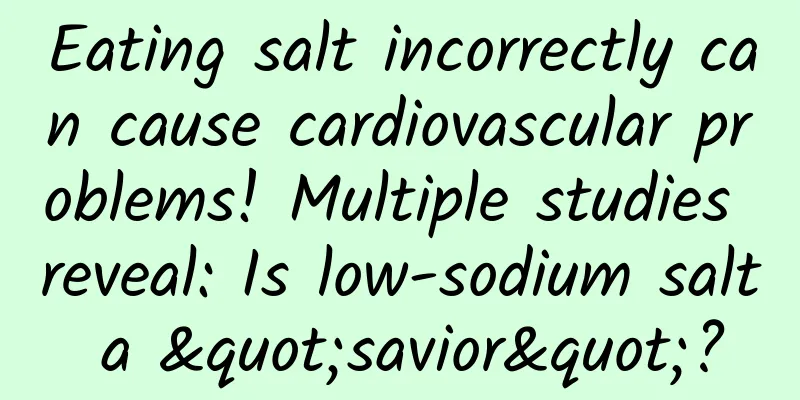Eating salt incorrectly can cause cardiovascular problems! Multiple studies reveal: Is low-sodium salt a "savior"?

|
Salt, an indispensable condiment in daily life, adds flavor to food and is also necessary for human physiological functions. However, excessive intake of salt, especially the sodium component, has become an invisible killer of cardiovascular health. Chinese people generally have a heavy taste for food, and their salt intake has long exceeded the standard. According to statistics, the daily salt intake of Chinese residents generally exceeds 6 g, which is much higher than the 5 g recommended by the World Health Organization. The main component of salt is sodium chloride, and sodium is a key factor in high blood pressure. Excessive sodium intake can cause water retention in the body, increase the burden on the heart, and then cause high blood pressure. Long-term high blood pressure can damage blood vessel walls and increase the risk of cardiovascular disease. In fact, about 1/7 of cardiovascular deaths in China can be attributed to excessive sodium intake. Therefore, salt reduction is imperative! Research and practice of low sodium salt As early as 10 years ago, my country launched the Chinese Salt Replacement and Stroke Study to explore the effect of low-sodium salt, in which 25% potassium chloride replaces sodium chloride, on the prevention of cardiovascular disease. This large-scale cluster randomized trial was conducted in several provinces in northern China, and included 15,249 stroke patients with a median follow-up of 61.2 months. The results showed that the stroke recurrence rate in the low-sodium salt group was significantly lower than that in the regular salt group, with a risk reduction of 14%, including a 30% reduction in the risk of hemorrhagic stroke; the participants' risk of death was also significantly reduced by 12%, and the risk of stroke-related death was reduced by 21%. These data provide strong evidence for the health benefits of low-sodium salt. In addition, the study revealed that for high-risk groups of cardiovascular disease with a history of stroke or poorly controlled hypertension aged 60 and above, consuming low-sodium salt can reduce the incidence of stroke by 14%, the incidence of major cardiovascular events by 13%, and the incidence of all-cause mortality by 12%, without increasing the risk of serious adverse events caused by hyperkalemia. Another analysis pointed out that if low-sodium salt containing 25% potassium chloride is used to replace table salt in China, 450,000 cardiovascular deaths can be reduced each year. The effects of low sodium salt on stroke recurrence and mortality risk also showed differences in different types of stroke. The risk of hemorrhagic stroke was reduced by 30%; the risk of unexplained stroke was reduced by 21%; and there was no significant difference in the risk of ischemic stroke. In addition, the risk of all-cause mortality in the low sodium salt group was also reduced by 12%, of which the risk of stroke-related mortality was reduced by 21%. The results of the survival curve analysis showed that the effect of low sodium salt was already evident in the first few months and persisted during the subsequent study. These data show that low sodium salt can not only reduce the risk of stroke recurrence, but also significantly reduce stroke-related deaths, providing new hope for the recovery and survival of stroke patients . A study published in South Africa in JAMA Cardiology at the same time also showed the effectiveness of salt reduction policies. South African legislation limits the sodium levels in 13 types of processed foods, reducing the sodium intake of the population at the policy level. The results showed that after reducing sodium intake, the sodium intake of the middle-aged and elderly population decreased significantly, and the proportion of people reaching the ideal intake (<2 g/d) increased from 7% to 17%. The average blood pressure of the study population dropped significantly, and every 1g reduction in sodium intake was associated with a 1.3 mm/Hg decrease in systolic blood pressure. These two studies provide evidence of the benefits of dietary sodium reduction for the prevention and recurrence of cardiovascular disease, and emphasize the importance of personal lifestyle changes and policy support. Challenges and suggestions for low sodium salt The composition of low-sodium salt is different from that of ordinary salt. By partially replacing sodium chloride, the sodium content is reduced while the potassium content is increased. Potassium is an electrolyte that is beneficial to the human body. It can help maintain normal blood pressure levels and reduce the risk of cardiovascular disease. The promotion and use of low-sodium salt not only contributes to individual health, but also reduces the burden of cardiovascular disease from a public health perspective. However, the popularization of low-sodium salt still faces some challenges, including insufficient public awareness of low-sodium salt and insufficient market promotion efforts. Changing personal lifestyle habits is an important part of preventing cardiovascular disease. In addition to choosing low-sodium salt, attention should also be paid to the diversity and balance of diet, increasing the intake of vegetables and fruits, and reducing the intake of high-salt and high-fat foods. In addition, moderate exercise, quitting smoking and limiting alcohol, and maintaining a good mental state are also important measures to maintain cardiovascular health. Not only that, policy support also plays an important role in salt reduction actions. Strengthening public health publicity and raising public awareness of the importance of salt reduction are important contents of policy support. In short, as a healthy condiment, low-sodium salt has shown significant effects in preventing cardiovascular disease, reducing the risk of stroke recurrence and death. Scientific research provides us with strong evidence, and changes in personal living habits and policy support are the key to achieving these health goals. In the future, with the popularization of low-sodium salt and the promotion of a healthy lifestyle, we are expected to see a further decline in the incidence of cardiovascular disease and bring more benefits to public health. Let us start with every meal, choose low-sodium salt, protect cardiovascular health, and share a better life. References: [1]Ding X, Zhang [2] Gaziano T, Kapaon D, du Toit JD, et al. Sodium Reduction Legislation and Urinary Sodium and BloodPressure in South Africa. JAMA Cardiol. Published online February 05, 2025. doi:10.1001/jamacardio.2024.5410 |
>>: New Fudan study: The impact of low-dose CT screening on the diagnosis of lung cancer in women
Recommend
Experts say it is better to have one child
Since the two-child policy was opened to the publ...
Strawberries are the "dirtiest fruit"? Why do experts recommend eating them? The truth is...
This article was reviewed by Pa Li Ze, chief phys...
Where are there more eels in reservoirs? What are the techniques for fishing eels in reservoirs?
It is not certain whether there are eels in the r...
Can women eat soybeans during menstruation?
Soybeans are a kind of food that we often eat in ...
What novel is Da Ming Feng Hua based on? Da Ming Feng Hua txt free reading resources Baidu Cloud
The Glory of the Ming Dynasty, starring Tang Wei ...
What to do if there is dampness and heat in the body? Recommend three dietary therapies
If there is too much moisture in the human body, ...
Don't take acute diarrhea lightly; it can be fatal if not properly treated
Author: Gong Fangchen: Ruijin Hospital Affiliated...
What should women do when their legs are sore and their lower limbs are weak?
Women's health is easily affected by various ...
How to drink white peony tea to lose weight? What should you pay attention to when drinking white peony tea to lose weight?
Drinking tea is a good way to get rid of greasine...
38 weeks of pregnancy, signs of labor
Women's hard pregnancy for ten months means w...
12 weeks pregnant
Every pregnant woman should determine whether to ...
Treatment of vaginal papilloma
Tumors are very common diseases. This type of dis...
Are weekend couples' marriages reliable? What are the disadvantages of weekend couples?
"Weekend couples" are a happy couple wh...
Can women do yoga during menstruation?
Yoga is a healthy sport that is not only benefici...









